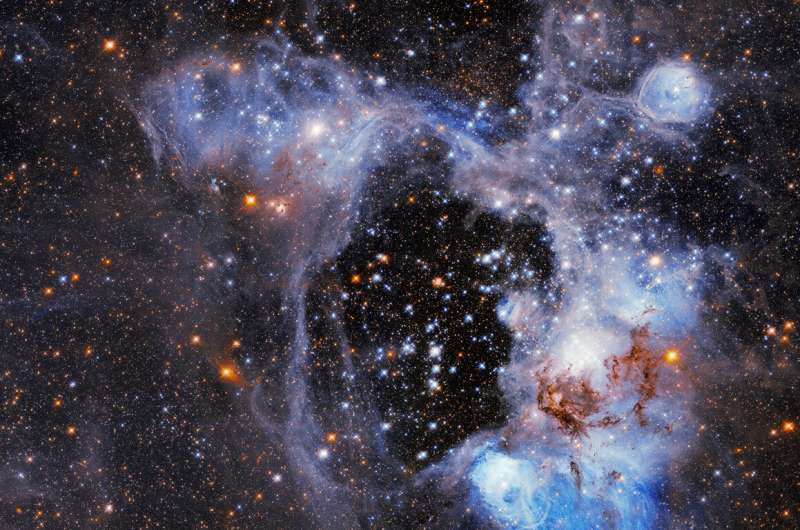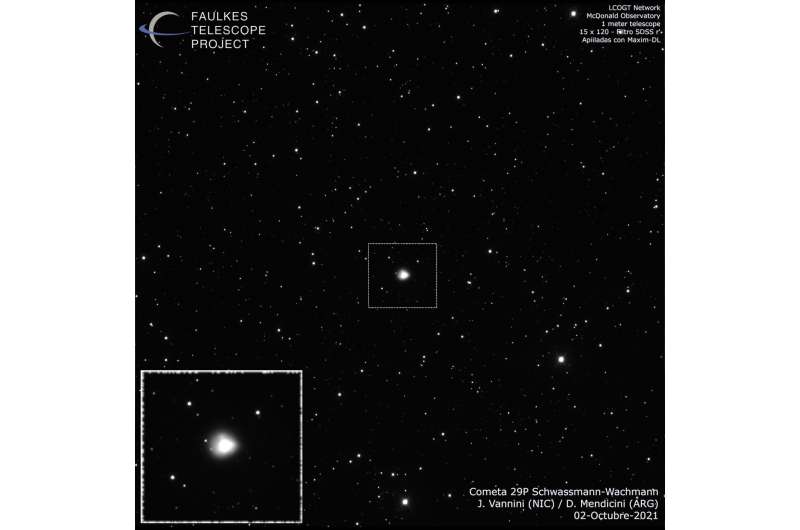Mysterious "superbubble" hollows out nebula in new Hubble image

N44 is a complex nebula filled with glowing hydrogen gas, dark lanes of dust, massive stars, and many populations of stars of different ages. One of its most distinctive features, however, is the dark, starry gap called a "superbubble," visible in this Hubble Space Telescope image in the upper central region.
The hole is about 250 light-years wide and its presence is still something of a mystery. Stellar winds expelled by massive stars in the bubble's interior may have driven away the gas, but this is inconsistent with measured wind velocities in the bubble. Another possibility, since the nebula is filled with massive stars that would expire in titanic explosions, is that the expanding shells of old supernovae sculpted the cosmic cavern.
Astronomers have found one supernova remnant in the vicinity of the superbubble and identified an approximately 5 million year difference in age between stars within and at the rim of the superbubble, indicating multiple, chain-reaction star-forming events. The deep blue area at about 5 o'clock around the superbubble is one of the hottest regions of the nebula and the area of the most intense star formation.
N44 is an emission nebula, which means its gas has been energized, or ionized, by the radiation of nearby stars. As the ionized gas begins to cool from its higher-energy state to a lower-energy state, it emits energy in the form of light, causing the nebula to glow. Located in the Large Magellanic Cloud, N44 spans about 1,000 light-years and is about 170,000 light-years away from Earth.
A beautiful instance of stellar ornamentation
Provided by NASA's Goddard Space Flight Center
Mysterious comet has been having multiple large outbursts

Amateur and professional astronomers have found that the comet 29P/Schwassmann-Wachmann has been experiencing an unusually large outburst recently. Normally, it has little outbursts spread throughout the year.
Comet 29P was discovered in 1927 and shortly thereafter was found to be orbiting the sun on a planet-like path in the space between Jupiter and Saturn. It was also found to be very large—approximately 60 kilometers across. Later, astronomers found that it behaved differently than other comets. Instead of shedding material as its outer layers melted during close fly-bys to the sun, it exhibited a kind of explosive behavior on occasion. Something was being ejected from the comet's interior, making the comet shine extremely brightly. The ejecta then fell back to the comet, adding a coating. Further study showed that periodically, a much larger outburst would occur and the comet would shine even more brightly. Such a huge outburst has been happening again, this time it started at the end of September.
Their research has shown that both the small outbursts and the large outbursts are unpredictable. In this latest outburst, there have been multiple eruptions and the comet grew in brightness to approximately 250 times that of its normal luminosity.
Notably, nobody knows why the comet erupts, though it does appear that the large outbursts work in ways similar to some volcanos. The ejecta from the small eruptions cover the exterior of the comet, creating a sort of shell. This, researchers suggest, leads to a build-up of pressure. Eventually, the pressure is strong enough to break through the icy crust, leading to a very large eruption.
In a novel twist, most of the research conducted regarding comet 29P has been done by amateurs with backyard telescopes. Time on the big telescopes has grown so competitive that most of the pros tend to focus on larger more important projects. The amateur astronomy community was hoping to learn more about the comet during this large outburst, however, as several professional teams requested and were granted time on the Hubble Space Telescope to peer at the comet. Sadly, these hopes were dashed as Hubble experienced technical problems that prevented it from pointing at the comet in time to catch its massive outburst in action.The biggest comet ever seen will get as close as Saturn in 2031
© 2021 Science X Network
No comments:
Post a Comment